Discover Florida Nature
It's time to explore the natural Florida


|
|
|
DemographicsHistory George AbbottJimmy BuffetRay CharlesHarry CrewsEarl CunninghamMartin Johnson HeadeErnest HemingwayFlorida HighwaymenZora Neal HurstonJames Weldon JohnsonJohn Rosamond JohnsonLawrence "Hank"
LocklinWill McLeanAddison MiznerVictor NunezMajorie Kinnan RawlingsRobert RauschenbergBurt ReynoldsGamble RogersJames RosenquistPatrick D. SmithTennessee WilliamsEllen Taaffe Zwilich Dunes & Maritime
ForestsFreshwater MarshesHammocksInshore
Marine HabitatsMangrovesPine
Flatwoods & Dry PrairiesSalt MarshesScrub & High PineSouth Florida
RocklandSwampsTropical Reefs Environmental IssuesCoastlineGeographyAmelia IslandAnclote KeyBig Shoals Public LandsBiscayne National ParkBlackwater River State ParkBlowing Rocks State ParkBlue Mountain BeachCanaveral National
SeashoreCaptiva IslandCedar KeyCoconut CreekCollier-Seminole State
ParkCrystal RiverDog IslandEverglades National ParkFalling Water State ParkFanning SpringsFort FosterGrayton Beach Henderson BeachHomosassa Springs ParkIndian KeyJonathon Dickinson ParkMarjorie Rawlings
SiteMyakka River State ParkNatural BridgeOcala National ForestPanacea AreaPaynes PrairieRainbow RiverRavine State GardensSanibel IslandSebastin InletSilver SpringsSt. AugustineSt. George IslandSt. Joseph PenisulaSuwannee River AreaTallahassee Museum Endangered Amphibians Endangered Birds (2)Endangered Birds (3)Endangered Birds (4)Endangered Birds (5)Endangered Birds (6) Endangered Mammals
(2)Endangered Mammals
(3)Endangered Mammals
(4)Endangered Mammals
(5)Endangered Mammals
(6) Florida Black BassFlorida CatfishFlorida GarFlorida PanfishFlorida PickerelsFlorida Stripers BearMink AlligatorsAmerican CrocodileAnoles CottonmouthDusky Pygmy RattlesnakeEastern Coral SnakeEastern Diamondback
RattlesnakeSouthern CopperheadTimber Ratller Hognose Garter, Ribbon
CoachwhipsMisc. SnakesPine King Brown Indigo SnakesRacers Rat Rough Green SnakesUnique Florida Snakes American Beautyberry-Bay Buttonbush-DeerberryDevils Walking Stick-FigsFirebush-Groundsel TreeGulf Greytwig-InkberryMagnolia-MyrsineMyrtle-OakPalm Trees-PawPawPine-RosemaryRouge -Spanish BayonetSt. John's-Wort-VanishleafWater Toothleaf-Willow |
|
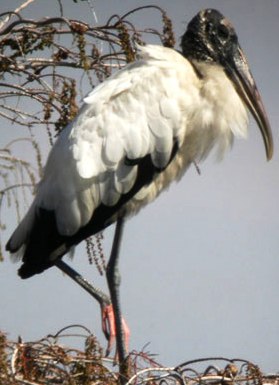 Wood
Stork
(Mycteria americana) Endangered- Wood storks are tall, white denizens of
freshwater or brackish wetlands and swamps. They can be identified by
their long legs, featherless heads, and prominent bills. These waders
feed on minnows in shallow water by using their bills to perform a rare
and effective fishing technique. The stork opens its bill and sticks it
into the water, then waits for the touch of an unfortunate fish that
wanders too close. When it feels a fish, the stork can snap its bill
shut in as little as 25 milliseconds—an incredibly quick reaction time
matched by few other vertebrates. A large, white, bald-headed wading
bird of the southeastern swamps, the Wood Stork is the only stork
breeding in the United States. Its late winter breeding season is timed
to the Florida dry season when its fish prey become concentrated in
shrinking pools. Wood
Stork
(Mycteria americana) Endangered- Wood storks are tall, white denizens of
freshwater or brackish wetlands and swamps. They can be identified by
their long legs, featherless heads, and prominent bills. These waders
feed on minnows in shallow water by using their bills to perform a rare
and effective fishing technique. The stork opens its bill and sticks it
into the water, then waits for the touch of an unfortunate fish that
wanders too close. When it feels a fish, the stork can snap its bill
shut in as little as 25 milliseconds—an incredibly quick reaction time
matched by few other vertebrates. A large, white, bald-headed wading
bird of the southeastern swamps, the Wood Stork is the only stork
breeding in the United States. Its late winter breeding season is timed
to the Florida dry season when its fish prey become concentrated in
shrinking pools.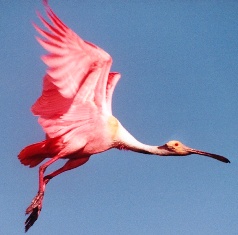 Roseate
Spoonbill
(Platalea ajaja) SSC- The most distinctive characteristic of
the roseate spoonbill is its long spoon-shaped bill. It has a white head
and chest and light pink wings with a darker pink fringe and very long
pink legs. The roseate spoonbill is about two and a half feet in length
with a wingspan of about four and a half feet. Both males and females
have the same plumage and coloring. The male is slightly larger than the
female and its bill is a little longer. The roseate spoonbill can be
found on the coasts of Texas, Louisiana and southern Florida. It is also
found in the tropics and in Central and South America. The roseate
spoonbill lives in mangrove swamps, tidal ponds, saltwater lagoons and
other areas with brackish water., spending lots of time in the water
looking food like small fish, shrimp, mollusks, snails and insects. Roseate
Spoonbill
(Platalea ajaja) SSC- The most distinctive characteristic of
the roseate spoonbill is its long spoon-shaped bill. It has a white head
and chest and light pink wings with a darker pink fringe and very long
pink legs. The roseate spoonbill is about two and a half feet in length
with a wingspan of about four and a half feet. Both males and females
have the same plumage and coloring. The male is slightly larger than the
female and its bill is a little longer. The roseate spoonbill can be
found on the coasts of Texas, Louisiana and southern Florida. It is also
found in the tropics and in Central and South America. The roseate
spoonbill lives in mangrove swamps, tidal ponds, saltwater lagoons and
other areas with brackish water., spending lots of time in the water
looking food like small fish, shrimp, mollusks, snails and insects.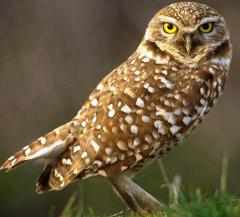 Burrowing
Owl
(Athene cunicularia) SSC- Burrowing owls have white eyebrows
yellow eyes and long legs. They lack the eartufts common to most owls.
Burrowing owls are sandy colored with with white to cream barring on
their chest. These owls are 8 -11 inches in length, weigh around 6-8
ounces and have a wing span of 20-24 inches. Burrowing Owls can build
their own homes, but they prefer to live in old prairie dog holes. Often
many owls live together in a social group. They are active both day and
night and can often be seen standing guard outside their burrows.
Burrowing owls fly with irregular wing beats. They hover during hunting
and courtship, and may flap their wings asynchronously (not up and down
together). Burrowing
Owl
(Athene cunicularia) SSC- Burrowing owls have white eyebrows
yellow eyes and long legs. They lack the eartufts common to most owls.
Burrowing owls are sandy colored with with white to cream barring on
their chest. These owls are 8 -11 inches in length, weigh around 6-8
ounces and have a wing span of 20-24 inches. Burrowing Owls can build
their own homes, but they prefer to live in old prairie dog holes. Often
many owls live together in a social group. They are active both day and
night and can often be seen standing guard outside their burrows.
Burrowing owls fly with irregular wing beats. They hover during hunting
and courtship, and may flap their wings asynchronously (not up and down
together).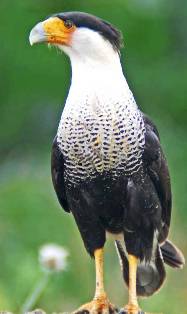 Crested
Caracara
(Caracara Cheriway) Threatened- The Crested Caracara has a body length
of 19 - 23 inches, a 4-foot wingspan, and weighs 1 3/4 - 3 1/2 pounds.
The bird’s weight varies greatly depending on where it lives. The
Crested Caracaras’ preferred habitat is open, lowland countryside, like
pastures, savannas, river edges, and ranches. They may also be found in
some forests and marshes. These birds reside in the southwestern United
States and Florida, Central America, and South America. The Crested
Caracara usually feeds on carrion, but they will take advantage of any
food opportunity by eating small mammals, amphibians, reptiles, turtles,
fish, crab, eggs, insects, worms, and nestling birds. Caracaras hunt
live food on the ground or take food from other birds. Crested
Caracara
(Caracara Cheriway) Threatened- The Crested Caracara has a body length
of 19 - 23 inches, a 4-foot wingspan, and weighs 1 3/4 - 3 1/2 pounds.
The bird’s weight varies greatly depending on where it lives. The
Crested Caracaras’ preferred habitat is open, lowland countryside, like
pastures, savannas, river edges, and ranches. They may also be found in
some forests and marshes. These birds reside in the southwestern United
States and Florida, Central America, and South America. The Crested
Caracara usually feeds on carrion, but they will take advantage of any
food opportunity by eating small mammals, amphibians, reptiles, turtles,
fish, crab, eggs, insects, worms, and nestling birds. Caracaras hunt
live food on the ground or take food from other birds.
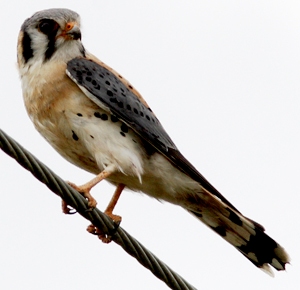 Southeastern
American Kestrel
(Falco sparverius paulus) Threatened- Once widely distributed
throughout seven southeastern states, the Southeastern American Kestrel
today occurs primarily in Florida but can be found elsewhere in patches
distributed in the coastal plains of South Carolina, Georgia, and
Louisiana. Within Florida, the Southeastern American Kestrel was once
distributed as far south as Dade County but now breeds no farther south
than Highlands and Lee counties. The Southeastern American Kestrel is
the smallest falcon in the United States, slightly larger than a Florida
Scrub-Jay and slightly smaller than a Mourning Dove. Male American
Kestrels have blue-gray wings, while females are slightly larger and
have brownish wings. Both sexes have brownish backs and buffy-white, or
off-white, undersides with a black flecking, and have distinct black
marks extending downward below the eyes. Southeastern
American Kestrel
(Falco sparverius paulus) Threatened- Once widely distributed
throughout seven southeastern states, the Southeastern American Kestrel
today occurs primarily in Florida but can be found elsewhere in patches
distributed in the coastal plains of South Carolina, Georgia, and
Louisiana. Within Florida, the Southeastern American Kestrel was once
distributed as far south as Dade County but now breeds no farther south
than Highlands and Lee counties. The Southeastern American Kestrel is
the smallest falcon in the United States, slightly larger than a Florida
Scrub-Jay and slightly smaller than a Mourning Dove. Male American
Kestrels have blue-gray wings, while females are slightly larger and
have brownish wings. Both sexes have brownish backs and buffy-white, or
off-white, undersides with a black flecking, and have distinct black
marks extending downward below the eyes. Osprey
(Pandion haliaetus) SSC- The Osprey, sometimes known as the sea
hawk, is a diurnal, fish-eating bird of prey. It is a large raptor,
reaching 24 inches in length with a 6 foot wingspan. It is brown on the
upperparts and predominantly greyish on the head and underparts, with a
black eye patch and wings. A short tail and long, narrow wings with four
long, finger-like feathers, and a shorter fifth, give it a very
distinctive appearance. The Osprey tolerates a wide variety of habitats,
nesting in any location near a body of water providing an adequate food
supply. As its other common name suggests, the Osprey's diet consists
almost exclusively of fish. It has evolved specialized physical
characteristics and exhibits unique behavior to assist in hunting and
catching prey. Osprey
(Pandion haliaetus) SSC- The Osprey, sometimes known as the sea
hawk, is a diurnal, fish-eating bird of prey. It is a large raptor,
reaching 24 inches in length with a 6 foot wingspan. It is brown on the
upperparts and predominantly greyish on the head and underparts, with a
black eye patch and wings. A short tail and long, narrow wings with four
long, finger-like feathers, and a shorter fifth, give it a very
distinctive appearance. The Osprey tolerates a wide variety of habitats,
nesting in any location near a body of water providing an adequate food
supply. As its other common name suggests, the Osprey's diet consists
almost exclusively of fish. It has evolved specialized physical
characteristics and exhibits unique behavior to assist in hunting and
catching prey.
|
|
|
Advertise | Privacy Statement | Dog Encyclopedia | Video |Contact | Alaska Nature |
|